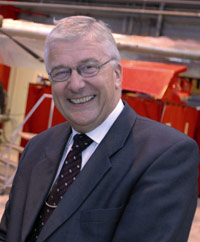One way to stand out in a crowd is to go somewhere where there are no madding crowds, and this seem to be the thinking behind Air Greenland’s move to choose the Baltimore airport for its first and (likely) only US gateway.
Flemming Knudsen, the Greenland carrier’s president and managing director, tells Airline Business that “we wanted an airport where we would not be just another airline, but one where we stand out, and Baltimore was ideal for that.” The airport, officially Baltimore-Washington International Thurgood Marshall Airport but known everywhere as BWI, “went out of its way to welcome us and help us with our US gateway,” Knudsen said while at Charm City’s airport for the official announcement of the May 2007 start-up.
BWI’s shiny international terminal has long experienced ups and downs in its roster, with carriers sometimes staying in, sometimes pulling out and sometimes operating seasonally. But for Knudsen, the airport’s large domestic scorecard, the presence of low-cost connections and the relatively unburdened customs, immigration and baggage infrastructure all help out. “We will be landing in the early afternoon, which time has very few arriving international flights and that will make it easy for people to make connections,” he says.
 The airline will use its 200-seat Boeing 757s, initially flying once a week and twice a week during the peak summer months. Greenland knows it isn’t well known and will rely on airport marketing and on its first ever general sales agents, AviaReps. AviaReps will entice travel agents to sell other products in the Greenland Air group, which includes tourist services and the Hotel Arctic in Ilulissat. Ilulissat is not far from the airline’s base at the Kangerlussuaq/Sønderstrøm airport, which Knudsen pronounced lovingly, indeed with some pleasure. The rest of us are welcome to use the abbreviation (SFJ).
The airline will use its 200-seat Boeing 757s, initially flying once a week and twice a week during the peak summer months. Greenland knows it isn’t well known and will rely on airport marketing and on its first ever general sales agents, AviaReps. AviaReps will entice travel agents to sell other products in the Greenland Air group, which includes tourist services and the Hotel Arctic in Ilulissat. Ilulissat is not far from the airline’s base at the Kangerlussuaq/Sønderstrøm airport, which Knudsen pronounced lovingly, indeed with some pleasure. The rest of us are welcome to use the abbreviation (SFJ).
Knudsen tells Airline Business that Greenland won’t compete with IcelandAir, which serves BWI on a seasonal basis and has long attracted bargain-basement travellers with its fares offering a stopover in Reykjavik and on to mainland Europe. But Greenland won’t be offering a through-fare, Knudsen says. Greenland’s major traffic base for its overseas scheduled Airbus A330 flights is traffic between Greenland and Scandinavia, and it also offers charter service for mineral exploration and scientific research customers. But Knudsen thinks the fares in the $1,000 (return) price range should attract ecotourists and people looking for a new experience. And as Iceland becomes familiar to adventure travels, Greenland should too.
The state-run airport has helped its domestic carriers, including Southwest, develop informal relationships with international carriers that may blossom into something more structured. As Knudsen puts it, “we have talked informally with the low-cost carriers and even though we haven’t developed a codeshare, we think passengers will be able to take advantage of connections”.
BWI has taken incessant criticism from the city’s only big daily, The Sun, over its $140 million international terminal, where a columnist chides that it “seems to specialise in the cold, the obscure and the surrounded-by water”. This seems to ignore Jamaica, London and Mexico City, although it could perhaps be construed to apply to the Gambia, which now has twice weekly BWI service. Knudsen sums up: “We wanted to go someplace where people were excited about us.”
Trust us, Flem, they were. They know they’re not Dulles, no matter what the hometown paper doesn’t know.
Source: Airline Business























